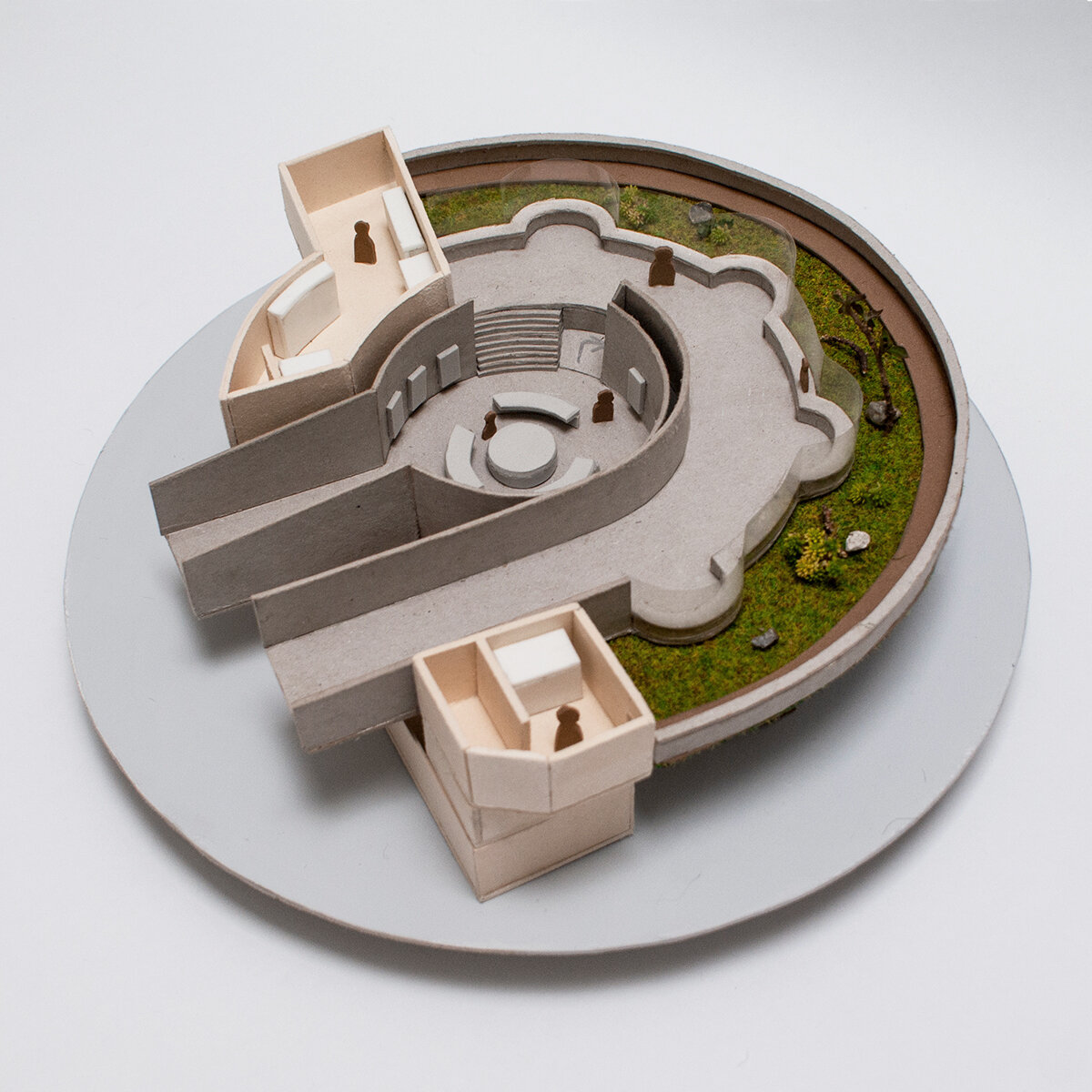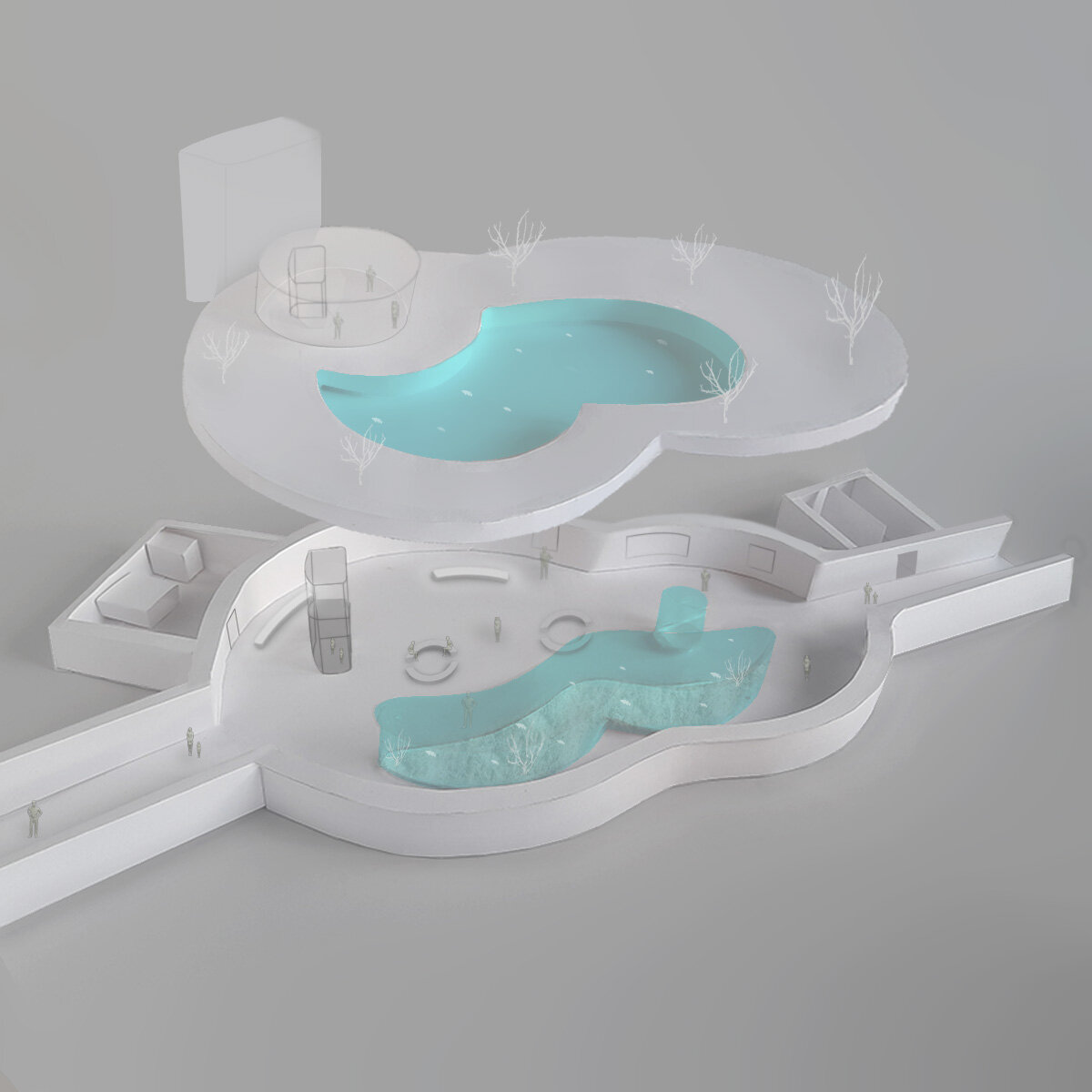DESIGN PROJECT 3 (CEM)
PROFESSORS: FRANCISCO HUNKEN / ANDREA URRUTIA
DESIGN FOR ANIMALS
Even today, most zoo enclosures are closer in concept to display cases for live animals than true habitats. The objective was to produce six enclosures for local fauna species that prioritize animal wellbeing while providing a positive visitor experience. Using a research-based approach and in consultation with animal behavior researchers, this is how we re-imagined the zoo.
THE SALAMANDER SANCTUARY
Karina Caro, Valeria Morán, and Sofía García
The Salamander Sanctuary is a space designed for small species, such as salamanders, where they can enjoy their natural habitat without being disturbed. This area responds to the needs and well-being of both visitors and salamanders, allowing a safe interaction and providing information on the overall habitat. The sanctuary consists of three areas:
-The information center: space in which visitors relate with interactive screens and videos that provide characteristics and images of the different types of salamanders found in the habitat.
-The enclosure: designed to improve the welfare of the salamander and imitate their natural environment.
-The storage: provides access to both ends of the habitat and has sufficient space for various tasks, such as veterinary requirements and tools or provisions zookeepers need to maintain the enclosure clean.
ECDISIS
Mónica Sánchez, Fernanda Ramírez and Ulises Gallegos
ECDISIS is a subterranean herpetarium that aims to be the home of the black-tailed rattlesnake.
Animal habitats should be as pleasant for animals to roam in as they are for guests to behold, for that reason this architectural project pursues 4 main goals: Provide animal care and welfare facilities, spark compassion, curiosity and conservation of the mexican endemic species, encourage others to become animal enthusiasts, and last, but not least, create a great guest experience through activities and interaction that connect visitors with the mesmerizing reptile world.
CONCOLOR
Malry Fuentes, Pamela Uribe and Xendi López
We redesigned an enclosure to improve the quality of life of a puma concolor in captivity and the visitor experience. Divided into two main areas: the natural enclosure and the underground exhibition, both connected by tunnels that allow a view of the animal from various angles.
The spaces are adapted in order to have services the people and the puma may need.
OPOSSUM
Andrea González, Diana García and Dafne Morales
The opossum habitat comes from the necessity of rethinking the old zoo systems, starting by prioritizing animal welfare instead of human entertainment. Our main goal is to educate the public so we can bring awareness to opossums' current situation and change the general idea of zoos.
Our concept revolves around the word “underground”, that is why our main exhibition is situated in an underground area which is connected to the enclosure area thanks to a very accessible platform. When the visitors arrive at the main exhibition room they are able to learn about the opossums while watching them thanks to our “underground” themed enclosure which reaches to the bottom of the room so the experience can start from the moment they get there.
MEXARIUM
Nancy Lizeth Martínez, Diana Montealegre, Mariana Pasillas and Eduardo Olvera
"Mexarium" is a space designed to find a new perspective on a conventional aquarium and improve the quality of life of the Mexican fish species: Mexcalpique de Zempoala, in addition to creating an interesting and enriching experience for visitors. Divided into two zones; the ground floor, where the fish tank is located and information about the species, such as its growth, reproduction, feeding, and vegetation that its habitat has. On the other hand, on the upper floor, visitors can see the area through a dome, where the habitat of the species is located in an open environment (connected to the fish tank), to preserve the principles of its natural environment, such as it is a lake or pond. This allows the user to observe the habitat of the Mexcalpique from different angles, while the species has the opportunity to move from open to closed space. Finally, "Mexarium" also has service spaces to preserve the space in optimal conditions, as well as service for users and bathrooms.
ARMADILLO’S ENCLOSURE
Mariana Elisa Nava Velázquez, José Vladimir Juárez Blas and Mirka Fuentes Ojeda
Armadillo’s section is an underground space that is designed to create an environment that meets the necessities and preservation of the armadillo. The enclosure, exhibition, zookeeper's room and dome are the parts of this space which offers visitors the experience of feeling inside the armadillo’s main habitat, the burrow, through: shapes, materials, textures and illumination.













